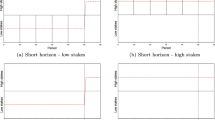Summary. Tacit coordination in large groups is studied in an iterated market entry game with complete information and multiple market capacities that are varied randomly from period to period. On each period, each player must decide independently whether to enter any of the markets, and if entering, which of the two markets to enter. Across symmetric and asymmetric markets, we find remarkable coordination on the aggregate level, which is accounted for by the Nash equilibrium, together with considerable individual differences in frequency of entry and decision rules. With experience, the decisions of most players converge to decision rules with cutoff values on the combined market capacity that determine whether or not to enter but not which of the two markets to enter. This latter decision is determined probabilistically by the differential market capacities. The aggregate and individual results are accounted for quite well by a reinforcement-based learning model that combines deterministic and probabilistic elements.
Similar content being viewed by others
Author information
Authors and Affiliations
Additional information
Received: January 29, 1999; revised version: October 25, 1999
Rights and permissions
About this article
Cite this article
Rapoport, A., Seale, D. & Winter, E. An experimental study of coordination and learning in iterated two-market entry games. Econ Theory 16, 661–687 (2000). https://doi.org/10.1007/PL00020947
Issue Date:
DOI: https://doi.org/10.1007/PL00020947




